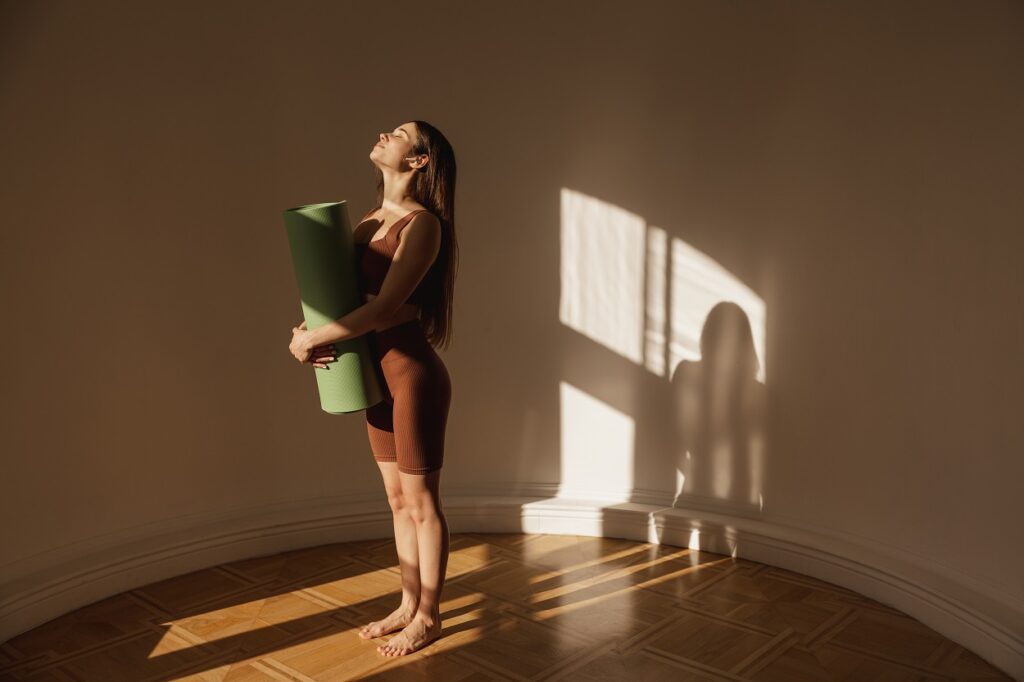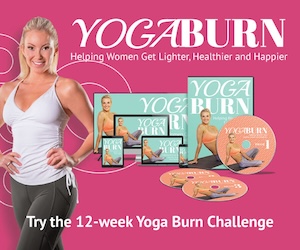Morning Yoga For Beginners:
Starting any new activity can be a difficult task. Yoga is no exception to this rule. Yoga, for beginners and those equally unfamiliar, can conjure up images of stretchy elastic pants and impossibly contorted looking poses. Specific to a time of day, we present, morning yoga for beginners!
Some poses may seem challenging, maybe impossible to some. However, if you delve deeper into the art form, you will see that yoga is more then just a physical workout. To demystify and teach the real meaning of yoga, we have created this guide to help get you going.

What Is Yoga?
Yoga is an old art form (including spiritual techniques and practices) that promotes physical and spiritual well-being. Yoga uses time tested techniques of breathing (pranayama), exercise, and meditation. Furthermore, these techniques combined, all have a purpose. Yoga not only aims to help calm the practitioner, enabling them to achieve true happiness and health (as more modern yogi’s would attest to), but is about achieving a cohesiveness or sort of togetherness with the universe.
When someone is doing yoga, they bend their body into specific postures, referred to as asanas or poses. Now, these poses overtime have been modified (like in chair yoga). In the modern era, these modifications allow for anyone to create a yoga routine that works for them. A yogi can incorporate props, like yoga blocks, wheels, bolsters, and even venture into aerial yoga, using hammocks and straps to elevate their practice.
Now it’s important to also remember that there are different forms of yoga. Most often when someone thinks yoga, Hatha yoga comes to mind. However, the many different forms, bring different thought processes or approaches to seamlessly lead to the same end goal of yoga.
Related Article: Why Yoga Works for Relaxation, Even for Beginners!
Benefits of Doing Yoga
Numerous benefits apply to physical and mental health from doing yoga daily. It’s possible to even see almost immediate benefits (of some kind) when performing just a few minutes of daily morning yoga for beginners. As yoga has become more main stream, yoga has now come face-to-face with research. Oftentimes, there is evidence backing many of the touted claims.
Physical Benefits of Yoga for Beginners:
Increased flexibility, improved posture, and relief from common daily aches and pains can all be achieved by practicing yoga regularly, it seems.
In fact, the NY Times posted an article that draws upon a few of these benefits. For example, that yoga can help keep your back and joints healthy, stretch and strengthen your muscles, and improve balance (as stated by a Iyengar yoga teacher).
Even the National Center for Complementary and Integrative Health (NIH) states research suggests, on top of the beforementioned benefits, yoga may also help relieve headaches, knee osteoarthritis, reduce blood pressure, help people lose weight, and improve overall quality of life.
Mental Benefits of Yoga For Beginners:
The mental and/or emotional benefits may be far reaching as well. Starting your day with increased mindfulness and a better sense of focus is only the start of the benefits of yoga.
Other benefits (according to research discussed by the NIH) include managing anxiety, stress, and/or depressive symptoms, improving sleep quality, as well as offering or aiding in smoking cessation.
Supplies You’ll Need:
Many exercise regimens require the purchase of expensive equipment or pricey access gyms. The low cost of entry and minimal required items, make yoga ideal for beginners. Firstly, the only essentials you need is proper fitting clothing and a yoga mat that fit’s your specific needs.
Proper clothing is important, mainly when transitioning between poses. Surely, you don’t want your clothes to distract you from focusing on your postures/session(s). An appropriate yoga mat is also important. Yoga mat’s not only differ in size and color, but also thickness, fabric and portability.
The yoga mat is vital to create traction, so you don’t slip when positioning yourself into certain postures. As you progress, other props may interest you, like yoga straps or yoga wheels, but from the start, the items needed are minimal.
Related Article: Popular Yoga Clothing: Types Of Yoga Pants
Where do I start if I’m a complete beginner?
If you know very little or nothing about yoga, out of shape, or inflexible, it’s best to start with a path of yoga that is gentle. Just a few gentle poses a day is a good starting place. Once you’ve mastered some beginner poses and foundation, build to more challenging poses or styles.
Specifically, you may want to stay away from more vigorous styles like vinyasa, or flow yoga classes. You may also want to avoid styles like hot yoga at the beginning, or Bikram.
In truth, the best place to start is in a group or class-type setting where you have an instructor who can help you find yourself within the practice.
Similarly to other fitness regimens or changes to your lifestyle, it’s important to stay consistent. In today’s world you are bound to have some “better days or weeks” then others, and that’s okay. If you’re a beginner to yoga, practicing 3 days a week should suffice.
Begin with 20 minute sessions and build from their. It’s hard to pinpoint when you’ll notice improvements as everyone’s starting point is different. However in general, if you’re regular with your practice, you should see improvements in range of motions (ROM) of joints, flexibility, strength and balance after the first few weeks.
Morning Yoga For Beginners, Poses:
Now that you are familiar with yoga, what it can do, and what you need, it’s time to learn a few basic poses that are great starting points when learning yoga, for beginners.
Child’s Pose (Balasana)
A beginner friendly pose, often seen in restorative type yoga styles, Childs pose is a forward-bend type pose. Furthermore, Balasana targets the lower back, hips, feet, ankles, and knees.
Steps:
1. Come onto all fours.
2. Then, come back, siting on your heels. Your knees will be wide and big toes touching.
3. Bend forward at the hips, crawling your fingers forward in front of you.
4. Allow your forehead to rest on the mat (or turn your head to the side). Use yoga blocks if more comfortable for your head to rest.
5. Listen and feel your breath.
Downward-Facing Dog (Adho Mukha Svanasana)
A staple in many yoga routines, even for beginner yogi’s. Downward Facing Dog (an inversion type asana) pose really integrates the entire body.
Steps:
1. Begin on all fours. Your hands should be shoulder-width apart.
2. Then, tuck your toes underneath. Afterward, begin to walk your feet back and hips up toward the ceiling.
3. Your heels don’t have to touch and knees can be slightly bent, as these will get better and more flexible with practice.
4. Your head should be relaxed, and below the heart. Gaze will be in-between your feet.
Related Article: What is the Meaning of Pranayama: Pranayama Breathing Techniques & Tips
Cobra Pose (Bhujangasana)
Cobra pose is another popularly practiced yoga pose, done in the prone position. This is a back-bend type asana. Additionally, with a focus of this pose being on the back, core, shoulders and arms.
Steps:
1. First begin prone on your mat, belly to the floor.
2. Then, place your hands beside your body. Your thumbs are within nipple line or slightly lower, elbows bent. Your fingers should be spread wide.
3. Chin to the mat.
4. Begin to bring your shoulder blades back, pressing into the floor with your fingers. Press down into the mat with the tops of your feet as well.
5. Focus on using the back to lift or arch your chest forward. Once in position, attempt to use your back muscles to maintain this position.
Corpse Pose (Savasana)
Savasana is done in the supine position and is a restorative-type pose. This is often the last pose of a yoga session.
Related Article: What Are Some Of The Best Times To Do Yoga?
Steps:
1. Begin on your back. Allow your feet to fall open, arms angled off to the side, palms up.
2. Then, press gently into the mat with your head, allowing your chest/heart to rise off the mat, then rounding your shoulder blades down.
3. Now relax. Close your eyes.
4. Release tension, relax your mind, breath calmly.
Final Thoughts!
Now that you are armed with all of the basics of yoga for beginners (as well as easy postures to do in the morning), you are ready to head deeper into this powerful technique. Yoga can provide benefits in almost all areas of your life and help you enjoy a healthier lifestyle.
It can be intimidating to start at first, but with enough practice, yoga will become an indispensable part of your daily routine. It is tough to become a master at yoga, but the ease of getting started is why yoga is great for beginners.
Above all, concentrate on beginning somewhere, and pushing yourself to stay consistent. Thanks for checking out our blog, please share our posts on your social media platforms!
Reverences:
- https://www.nytimes.com/guides/well/beginner-yoga
- https://www.nccih.nih.gov/health/yoga-what-you-need-to-know




